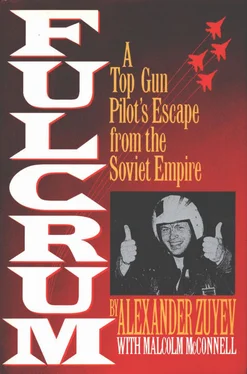The base slid past below. Closer, the city of Mikha Tskhakaya was a jumble of orange tile roofs surrounded by citrus groves. To the north, the towering wall of the Great Caucasus range stood, icy white and silent, marking the boundary between the Republic of Georgia and the Russian Federation. The Caucasus were splendid mountains, higher and more rugged than the Alps of Europe or North America’s Rockies. Some Swiss fellows I’d met skiing up there told me the Caucasus had more spectacular and dangerous runs than the Alps. I could believe that.
I shifted in my seat to stare south over the left wing. The Maliy Kavkaz mountains of the Turkish frontier were only half as tall as the Caucasus, but their summits were still crusted with winter snow. Below, the wide Rioni River glinted in the sun, meandering through the green coastal marshland toward the Black Sea ahead.
Enough nostalgic sight-seeing. It was time to verify that my cockpit was ready for a simulated dogfight with Lieutenant Colonel Shatravka. The training scenario called for us to use all three of our air-combat weapons systems: the long-range R-27 Alamo radar-controlled missile, the shorter range R-73 Archer infrared-homing missile, and the inboard GSh-301 30mm cannon mounted in the left fuselage below the cockpit. These weapons would rely on all three of the MiG-29’s modern sensor systems: the pulse-Doppler radar, the infrared search and track system (IRST), and the laser range finder. On training sorties the radar missiles were simulated by a small electronic pod mounted on the inboard pylon of my left wing. The sensor head simulating the infrared seeker of the Archer missile was in the inner pylon beside it.
We always flew with a full load of 30mm cannon ammunition — 150 shells — even on training flights. So it was important that the master arm switch on the weapons sensor control panel remain in the ‘off’ position. Once, a zampolit political officer had become confused on a bomber-intercept sortie and had turned on the master switch, thinking he needed that circuit to activate his gun camera. Apparently he had been too busy studying Marx and Lenin to read his aircraft manuals and hadn’t realized the cannon was loaded, even on training flights. The cannon had chattered off fifty rounds before the zampolit realized his mistake. Luckily, like most of his kind, the political officer was a shitty pilot. So he hadn’t shot down the Tu-16 bomber.
I checked out my aircraft for mock combat in the recommended manner, working from left to right, starting with the missile-select button on the number two throttle, then moving to the systems on the left, lower left cockpit console.
The MiG-29 was a “fourth generation” fighter that could engage or evade the best NATO aircraft at extreme or short ranges, throughout a wide flight envelope. Its powerful and complex weapons were linked to equally sophisticated sensors. Now I had to verify that I had chosen the correct weapons systems, and that the sensors, both the radar and the infrared search and track system, were ready for combat.
As the IRST would probably be used second, in the close-combat phase of the engagement, I began with the long-range radar missile control. The armament control panel was at the forward head of the left cockpit console. I flipped the lock-on switch to “friend,” which meant the radar could track and lock onto another Soviet aircraft, hopefully in this case, either Lieutenant Colonel Shatravka’s or Major Chayka’s MiG-29. If I had left the switch in the “enemy” position, the radar would have recognized their coded SRZO aircraft identification signals and not operated during the mock dogfight. I now verified that the munitions fusing system was set in the vozdukh “air” position, before moving on to the radar modes panel on the left forward instrument board.
In air combat today, combined aircraft closing speeds can total Mach 4 and the engagement can slash through 45,000 feet of vertical airspace in less than a minute. So human senses and reflexes can be inadequate to detect and defeat the enemy. Modern air-combat tactics, both Soviet and Western, call for a fighter pilot to destroy the enemy at extreme distances — “beyond visual range" — before that enemy’s stand-off missiles could be launched on friendly targets. A powerful and versatile radar is absolutely essential.
And the MiG-29’s improved NO-193 pulse-Doppler radar was a versatile and sensitive sensor and tracking system. But there was a lot of controversy about this radar in the Soviet Air Force. In intelligence briefings, I had learned that the radar was code-named “Slot Back” by NATO, which believed Soviet spies had stolen the basic technology from America’s Hughes Corporation. As they did about so much else in the modern arsenal of the Soviet Union, the Americans apparently chose to believe we had just slavishly copied their innovations. This was only partly true. Soviet scientists usually let their Western counterparts invest years and billions of dollars in basic research, which the Americans then dutifully published in their open aviation magazines. What detail was not available in the press, the Soviets then obtained through spies. Only then did Soviet designers set to work to modify and improve on the basic Western technology.
But the NO-193 radar was an interesting variation on this theme. The Soviet design bureau did, indeed, benefit from espionage. But after the equipment was perfected, the KGB discovered that a Soviet electronics expert who helped design this radar was actually working for Western intelligence. Not only had he fed our design details to the West, he had actually sabotaged the initial capabilities of this important system. The original NO-193 was very sensitive and could detect fast-moving targets at extreme range, but the set’s computer was incapable of holding the lock-on needed for missile launch. When we first tested this radar during the combat evaluation of the MiG-29 in 1985, my colleagues and I had been deeply disappointed in the capabilities of the “advanced” look-down, shoot-down pulse-Doppler radar.
A year later, after this Soviet traitor had been caught and executed, electronics technicians descended on our base to quietly install modifications to the radar, which allowed it to retain lock-on much more efficiently. Our Intelligence Directorate hoped that their NATO counterparts still believed the MiG-29’s radar was crippled by the sabotage of the Western mole.
I now quickly configured the radar modes panel. I planned to attack my opponents from below, so I turned the Delta-H switch to the number two position, which would set the antenna scan for anticipated targets about 6,000 feet above my flight level. Then I turned the radar modes switch to auto and the hemisphere switch to forward hemisphere. The radar’s computer would automatically take over the search and tracking of up to ten targets. This computer measured their relative speeds and ranges by Doppler effect, analyzed their closing angles, and presented the target in threat-priority order on the clear rectangular Plexiglas head-up display (HUD) above my main instrument panel. On a modern fighter the HUD was the pilot’s closest friend, the simplified window into the dense network of sensors and computers jammed into the nose of his aircraft. I left the radar in the nakal standby position, warmed up and ready, but not actively scanning the airspace ahead, so as not to be detected on an opponent’s radar-warning receiver.
The coast was coming up fast, and I would soon have to contact Brigadier, the Ground Control Intercept center in the bunker beside the regimental headquarters back at Ruslan. A battle-control officer at the Brigadier GCI center would be working with Nikolai and me today, feeding us data on the “enemy” formation we would engage. Lieutenant Colonel Shatravka’s flight would be directed by another controller sitting at a radar console in the same room as mine, but using a different radio channel. Today I had Senior Lieutenant Vitaly Shevchenko as my battle-control officer. I could picture those fellows down in “the pit,” craning forward in their chairs, glued to their radar screens. These engagements were not simply fought in the cockpits, the battle-control officers always reminded us. They got just as excited as we did.
Читать дальше










